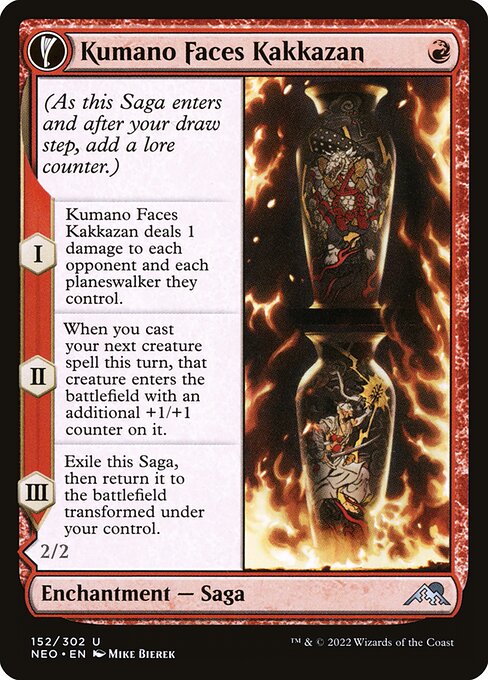熊野と渇苛斬の対峙 // 熊野の食刻
//
エンチャント — 英雄譚 // クリーチャー・エンチャント — 人間・シャーマン
(この英雄譚が出た際とあなたのドロー・ステップの後に、伝承カウンター1個を加える。)
I — 熊野と渇苛斬の対峙は各対戦相手と対戦相手がコントロールしている各プレインズウォーカーにそれぞれ1点のダメージを与える。
II — このターン、あなたが次にクリーチャー・呪文を唱えたとき、そのクリーチャーは追加で+1/+1カウンター1個が置かれた状態で戦場に出る。
III — この英雄譚を追放する。その後、これを変身させた状態であなたのコントロール下で戦場に戻す。 // 速攻
このターン、あなたがコントロールしている発生源からダメージを受けたクリーチャーが死亡するなら、代わりにそれを追放する。
I — 熊野と渇苛斬の対峙は各対戦相手と対戦相手がコントロールしている各プレインズウォーカーにそれぞれ1点のダメージを与える。
II — このターン、あなたが次にクリーチャー・呪文を唱えたとき、そのクリーチャーは追加で+1/+1カウンター1個が置かれた状態で戦場に出る。
III — この英雄譚を追放する。その後、これを変身させた状態であなたのコントロール下で戦場に戻す。 // 速攻
このターン、あなたがコントロールしている発生源からダメージを受けたクリーチャーが死亡するなら、代わりにそれを追放する。
2/2
standard
future
historic
gladiator
pioneer
explorer
modern
legacy
pauper
vintage
penny
commander
brawl
alchemy
paupercommander
duel
oldschool
premodern
Rulings
Each face of a transforming double-faced card has its own set of characteristics: name, types, subtypes, abilities, and so on. While a transforming double-faced permanent is on the battlefield, consider only the characteristics of the face that's currently up. The other set of characteristics is ignored.
The mana value of a transforming double-faced card is the mana value of its front face, no matter which face is up.
Each transforming double-faced card in this set is cast face up. In every zone other than the battlefield, consider only the characteristics of its front face. If it is on the battlefield, consider only the characteristics of the face that's up; the other face's characteristics are ignored.
If you are instructed to put a card that isn't a double-faced card onto the battlefield transformed, it will not enter the battlefield at all. In that case, it stays in the zone it was previously in. For example, if a single-faced card is a copy of Azusa's Many Journeys, the chapter III ability will cause it to be exiled and then remain in exile.
A transforming double-faced card enters the battlefield with its front face up by default, unless a spell or ability instructs you to put it onto the battlefield transformed or you cast it transformed, in which case it enters with its back face up.
The back face of a transforming double-faced card usually has a color indicator that defines its color.
The mana value of a transforming double-faced card is the mana value of its front face, no matter which face is up.
Each transforming double-faced card in this set is cast face up. In every zone other than the battlefield, consider only the characteristics of its front face. If it is on the battlefield, consider only the characteristics of the face that's up; the other face's characteristics are ignored.
If you are instructed to put a card that isn't a double-faced card onto the battlefield transformed, it will not enter the battlefield at all. In that case, it stays in the zone it was previously in. For example, if a single-faced card is a copy of Azusa's Many Journeys, the chapter III ability will cause it to be exiled and then remain in exile.
A transforming double-faced card enters the battlefield with its front face up by default, unless a spell or ability instructs you to put it onto the battlefield transformed or you cast it transformed, in which case it enters with its back face up.
The back face of a transforming double-faced card usually has a color indicator that defines its color.
Rulings
Each face of a transforming double-faced card has its own set of characteristics: name, types, subtypes, abilities, and so on. While a transforming double-faced permanent is on the battlefield, consider only the characteristics of the face that's currently up. The other set of characteristics is ignored.
The mana value of a transforming double-faced card is the mana value of its front face, no matter which face is up.
Each transforming double-faced card in this set is cast face up. In every zone other than the battlefield, consider only the characteristics of its front face. If it is on the battlefield, consider only the characteristics of the face that's up; the other face's characteristics are ignored.
If you are instructed to put a card that isn't a double-faced card onto the battlefield transformed, it will not enter the battlefield at all. In that case, it stays in the zone it was previously in. For example, if a single-faced card is a copy of Azusa's Many Journeys, the chapter III ability will cause it to be exiled and then remain in exile.
A transforming double-faced card enters the battlefield with its front face up by default, unless a spell or ability instructs you to put it onto the battlefield transformed or you cast it transformed, in which case it enters with its back face up.
The back face of a transforming double-faced card usually has a color indicator that defines its color.
The mana value of a transforming double-faced card is the mana value of its front face, no matter which face is up.
Each transforming double-faced card in this set is cast face up. In every zone other than the battlefield, consider only the characteristics of its front face. If it is on the battlefield, consider only the characteristics of the face that's up; the other face's characteristics are ignored.
If you are instructed to put a card that isn't a double-faced card onto the battlefield transformed, it will not enter the battlefield at all. In that case, it stays in the zone it was previously in. For example, if a single-faced card is a copy of Azusa's Many Journeys, the chapter III ability will cause it to be exiled and then remain in exile.
A transforming double-faced card enters the battlefield with its front face up by default, unless a spell or ability instructs you to put it onto the battlefield transformed or you cast it transformed, in which case it enters with its back face up.
The back face of a transforming double-faced card usually has a color indicator that defines its color.
Votre collection ? vos decks ?
Envie de gérer votre collection et/ou créer des decks ?

